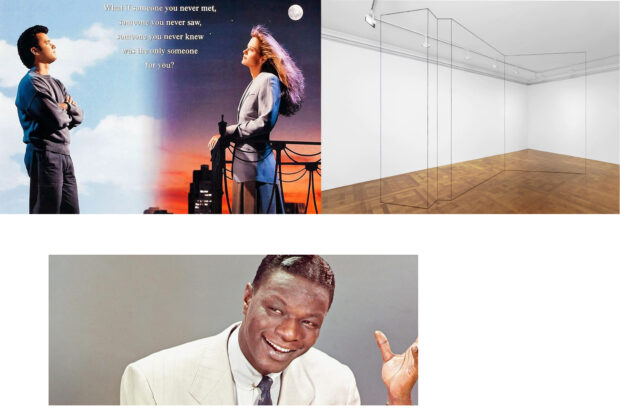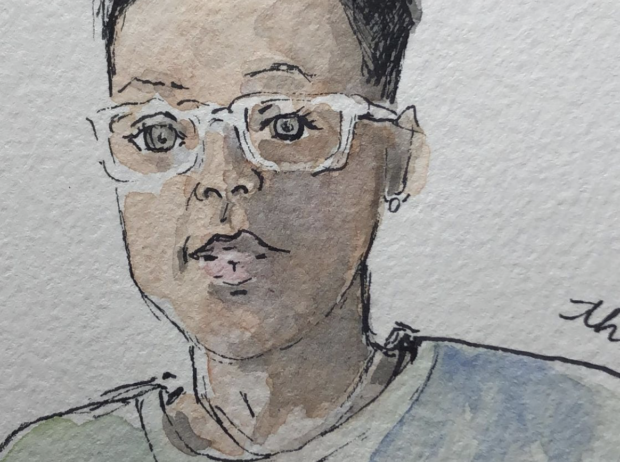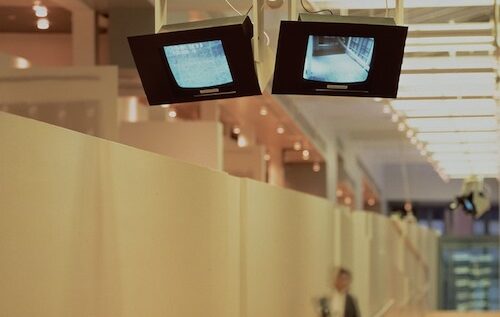Rachel Harrison spoke at the Institute of Fine Arts on February 24, 2011, as part of the IFA’s Artists at the Institute lecture series.

Asking an artist to give a lecture about her own work already seems kind of unfair. It’s not enough that they have to make these wonderful things, but they have to explain to us what they mean? To wrangle with those digital projections that we all hate? To tie up a whole lifetime of experiences and subjectivity into one neat little hour-long bundle (hour and ten minutes, if you include the Q & A)? But asking a sculptor to talk about her work—to add the inadequacy of photography in capturing anything, really, about these objects—well, that just seems downright mean.
Rachel Harrison seemed game enough to try, though, and despite all the obvious limitations of the slideshow format—or maybe even because those limitations echo some of her artistic concerns—she provided some pithy insights into her notoriously unwranglable works. There were no moments of total understanding or easy summaries of her body of work, but there were some interesting intersections of ideas and illuminations of corners here and there. Plus she got some of us stuffy art historians to laugh once in a while—pretty good for an hour and ten minutes.
One of the issues to which Harrison returned often was her relationship with photography. About her series of photographs of garbage left out in green bags on the streets of London, she said she was initially interested in using the camera to record time, but ended up with a fractured representation of time from the trip. Harrison also spoke about her work 5 x 7, in which she took a photo for which the correct color values would not be apparent and had it developed by ten different photo labs throughout the city. The varied tones of the resulting prints reveal something about what each developer of the film believed to be the truest color and show what Harrison called “the subjectivity of color.”
As part of her interest in interrogating photography and magnifying its subjectivity, Harrison discussed her work Snake in the Grass, which includes six photos of grass that Harrison claims were taken on the infamous Grassy Knoll in Houston. She explained that she was interested in how the photos were not informative about truth or place—that they might not actually have been taken at the notorious site. Yet another investigation into photographic representation is Harrison’s Perth Amboy series, a set of photographs of a window in a New Jersey home where the Virgin Mary supposedly appeared. Harrison said she was interested in the relationship between photography and the ephemeral image of the Virgin: the development of the exposed image. The way that people felt compelled to touch the window also interested Harrison, especially how visitors’ fingerprints eventually replaced the image with which they were trying to connect.
Much of the lecture also revolved around Harrison’s extensive use of found objects, the importance of context to the meaning of these objects, and the idea of collecting. At one point, Harrison described her work as a “reconfiguration of indigenous parts.” When an audience member asked what kinds of changes she made to the objects included in her installations, Harrison was explicit about the fact that she didn’t want to change them at all, so that “your relationship to it is unaltered by me.” As she explained, she wants to stick one thing on another thing so that they don’t affect each other, and so that they can go back to their respective spaces afterward.
In relation to the question of what could imbue a mass-produced object with uniqueness, Harrison also touched on her personal interest in collecting. She had heard that it was important for an artist to collect something, so in her first exhibition she included a number of cans of peas, since these objects were affordable and accessible. Then Harrison decided that she “really needed to focus [her] collection, to collect in depth.” This prompted her move to collecting canned olives—but only those with photographs of olives on the cans, which she used to great effect in Teaching Bo to Count. Harrison’s citations of where she got many of her found objects and photographs—most memorably, her description of how excited she was to find snapshots of Johnny Carson and Archie Bunker at a flea market—encouraged the audience to further consider the complex ways that uniqueness, choice, and indexicality function in Harrison’s work.
Of course, there were other ideas and themes that came up over the course of Harrison’s talk: the function of time in her work—her understanding of re-installations of her exhibitions and her approach to creating one installation in different locations; Barbie’s friend Becky, who uses a wheelchair—but the twin themes of the function of photography and the relationship of context to meaning and uniqueness are what I keep remembering from the talk. I think it’s because these themes were so relevant to these photographs of specific moments in time, which we relied on Harrison to contextualize for us, and to the total reconfiguration of all of these moments, which define the artist’s slide show. Maybe this whole thing was just one more messy, funny, confusing moment in Harrison’s work. Maybe I’m overthinking this. Still, though, pretty good for an hour and ten minutes.
Emily Sessions is a second-year MA candidate at the Institute of Fine Arts.






Be First to Comment